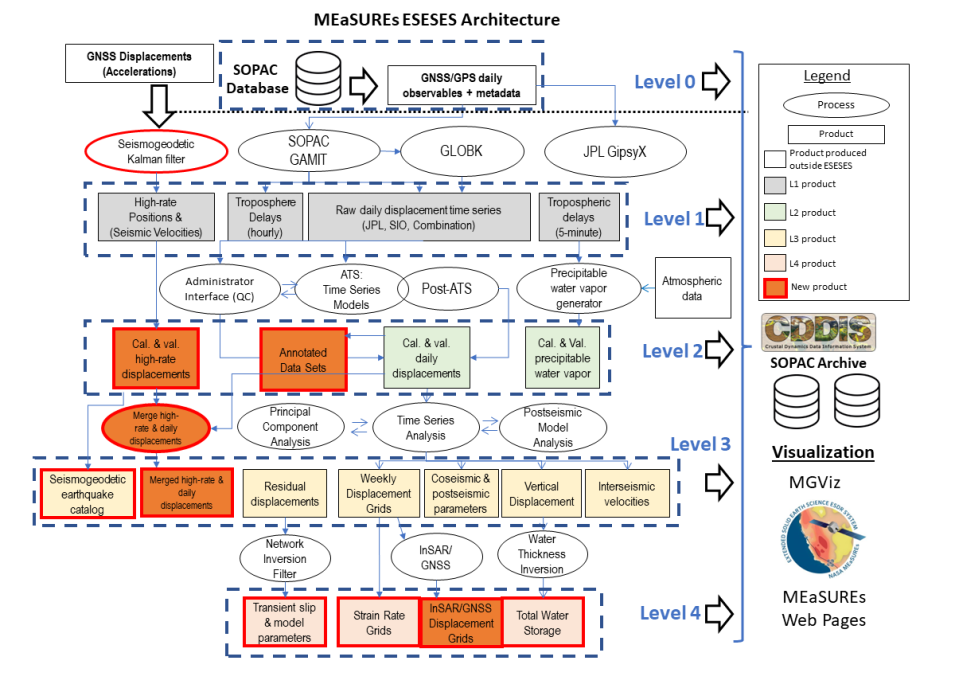Dr. Yehuda Bock, Distinguished Researcher and Senior Lecturer at the Scripps Institution of Oceanography's Institute of Geophysics and Planetary Physics
Research Interests: Crustal deformation, tectonics, and earthquake studies using space geodesy; mitigation of natural hazards using geodetic methods; meteorological and climatological applications of the Global Navigation Satellite System (GNSS); geodetic data science and machine learning.
Research Highlights: If there were a list of the technologies most often taken for granted, the Global Navigation Satellite System (GNSS) would be somewhere near the top. Although millions of people around the world rely on it every day to navigate from one address to another, share information over wireless networks, or fly on airplanes, it seems few are aware of the vast global network of ground receivers and the international constellation of satellites that make GNSS possible.
Among those who are familiar with GNSS and the myriad ways this technology benefits human civilization is Dr. Yehuda Bock, distinguished researcher and senior lecturer at the Scripps Institution of Oceanography’s (SIO) Institute of Geophysics and Planetary Physics in La Jolla, California. Along with his colleagues from SIO and NASA's Jet Propulsion Laboratory (JPL) in Southern California, Bock produces a suite of GNSS-derived data products as part of the Enhanced Solid Earth Science Earth Science Data Record System (ESESES), a project of NASA's Making Earth Science Data Records for Use in Research Environments (MEaSUREs) Program. ESESES is a collaborative activity between JPL and the Scripps Orbit and Permanent Array Center (SOPAC), a research group that uses geodetic and seismic data for a wide range of geodetic, geophysical, surveying, and engineering initiatives.
"We provide, on an operational basis, several levels of Earth science data records (ESDRs) using GNSS," Bock said of his work with the ESESES project. "These products, some of which extend more than three decades, are regularly published at NASA's Crustal Dynamics Data Information System (CDDIS), the agency's archive of space geodesy data."
Established in 1992 and located at NASA's Goddard Space Flight Center in Greenbelt, Maryland, CDDIS is one of the 12 Distributed Active Archive Centers (DAACs) in NASA's Earth Observing System Data and Information System (EOSDIS). CDDIS supports the international geodesy and greater scientific communities by archiving and freely distributing data derived from four geodetic techniques: satellite laser ranging (SLR), very long baseline interferometry (VLBI), Doppler Orbitography and Radiopositioning Integrated by Satellite (DORIS), and GNSS. In addition, CDDIS is a core component of the services established under the International Association of Geodesy (IAG), an organization that promotes scientific cooperation and research in geodesy on a global scale.
Geodesy is the science of determining the exact position of an instrument on Earth's surface to the centimeter or sub-centimeter level, and global cooperation is integral to its veracity and advancement. This cooperation is inherent in GNSS, which is made up of satellite navigation systems from several countries, including the U.S. Global Positioning System (GPS) and the European (GALILEO), Russian (GLONASS), and Chinese (BeiDou) systems. In addition, the international geodetic community has established GNSS monitoring stations at thousands of locations around the world. Each one of these stations contains an antenna and a receiver that picks up radio signals from the multitude of GNSS satellites. Using specialized geodetic software, scientists can then monitor the positions of these receiving stations—with a precision of about one millimeter—and track their movement (displacement) over time.
Bock and his ESESES colleagues use these data to create a variety of data products at different processing levels that scientists and resource managers in fields ranging from agriculture to seismology can use to better understand the processes that shape Earth's surface and their impact on both the natural and built environment.

